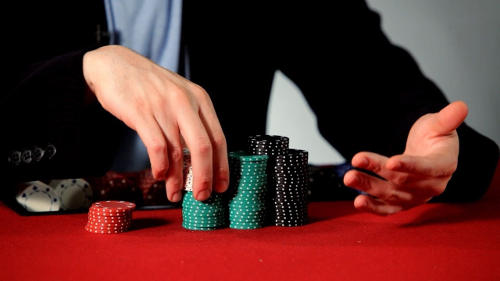Introduction
If you look over the past few weeks of my strategy column, you’ll see how this week’s topic came together. I had a set of Mental Tricks for Preperation in NLHE which was related to the Basics of Thinking Ahead in Poker. I also covered Double Barreling in NLHE in an incredible amount of detail with tons of links to previous threads to make it what could possibly be the largest resource ever created on the topic. Keeping with that theme, we’re going to look at multi-street bluffing in general this week.
How It’s Different Than a Single Street
Multi-street bluffing is different than betting on a single street because you see a second (or third) street some percentage of the time. If we’re talking about betting on three streets (call it the flop, turn and river) with a hand that has no outs and no chance of winning, we can have the following game tree if we’re out of position against a single opponent:
- Villain folds flop; we win the starting pot. (1)
- Villain raises flop; we lose our flop bet. (2)
- Villain calls flop; we bet the turn…
- Villain folds turn; we win the starting pot and flop bet. (3)
- Villain raises turn; we lose the flop bet and turn bet. (4)
- Villain calls turn; we bet the river…
- Villain folds river; we win the starting pot, flop bet and turn bet. (5)
- Villain raises river; we lose the flop bet, turn bet and river bet. (6)
- Villain calls river; we lose the flop bet, turn bet and river bet. (7)
What you can see from this game tree is that, even before we start to account for things like our opponent being out of position with a chance to lead a street, we have a lot of possible outcomes to contend with. Along these lines, it’s not practical to try to think through the entire game tree or operate from a position of EV calculations.
Instead, you should learn the general principles that are used to navigate these scenarios and learn what types of hands fit in well at each stage of the multi-street bluffing game. That’s what we’re going to focus on here.
The Continuation Bet Leading to the Double Barrel
The first connection you should be thinking about is the connection between the hands you make a continuation bet with and the hands you double barrel. In the link I gave above, there’s a whole ton of stuff about double barreling that I’m not going to rehash either. Instead, what I want to focus on is the relationship between the types of hands that you c-bet and double barrel with.
For example, if we’re continuation betting with a lot of draws and overcards, then we’re going to end up with draws and overcards on the turn. If we’re c-betting with random hands that don’t have any outs, that’s what we’re going to have to deal with on the turn as well. Your flop betting range determines the range that you hit the turn with, and that’s the point we want to drive home here.
The Double Barrel Leading to the River Bluff
On the river you want to be bluffing with hands that have no real showdown value. Thinking backwards, we have to consider the types of hands with no showdown value that could make it through the flop continuation bet and turn double barrel. The most common type of hand that will fit this mold is the missed draw, and this is the type of hand we want to focus on. Consider this:
If you want to have good hands to bluff with on the river, then you have to be bluffing on both the flop and the turn with draws of some type.
Now let’s look at this principle in action.
How River Ranges Are Formed
What we want to do here is show you how to get river bluffing ranges by making sure you actually have decent bluffing hands when you make it to the river. What you’ll see is that this will affect your play on both the flop and the turn as well.
A Standard, Semi-Wet Board
Suppose the board plays out QhTs4h6d7s. We could be c-betting, double barreling and firing the river with flush draws, AK, AJ, KJ and even J9 if we needed to. The point I want to make here is that we would have a lot of options to bluff three streets, so we’d need to temper our aggression on the river so that we aren’t accidentally bluffing too much since that’s a lot of hands to be barreling three streets with.
A Paired, Dry Board
Now suppose we have something like 8h8s4dJh2c. To have suitable river bluffing hands, we would have had to make a continuation bet on the flop with something that had some sort of equity like AK, AQ or KQ. Not only that, but we would also need to fire the second barrel on the turn with some of those hands as well. Finally, we would make it to the river with some of the combinations of those overcards, and that would give us bluffing options.
A Non-Paired, Dry Board
Let’s say we have AsJh7d4c2s. What you’ll notice is that we don’t have overcards or major draws to play with on the flop. This means we have to go with gutshots and runner flush draws, so something like KQ, KT or QT in spades, hearts or diamonds would be a fairly good bluffing hand to start with. Because there are so few strong bluffing hands available on the flop, we’d need to take most of them through the turn to the river so that we have something to temper our value-oriented double-barreling range with hands like sets, two pairs (Ax) and top pair hands with high kickers.
Submit your review | |









